.
.
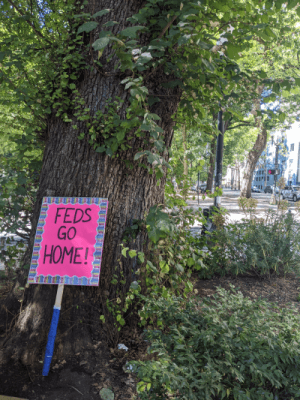
Lownsdale Square, Portland, Oregon; July 26, 2020
.
___
.
…..Portland is a great city in which to live. The neighborhoods are alive and colorful and, of course, hipster-chic. The Willamette River runs through a thriving downtown, with ten architecturally unique bridges connecting its east and west sides. The south and north shores of the Columbia River border Oregon and Washington, and are a short drive from downtown.
…..The ocean is an hour to the west, Mt. Hood is an hour to the east, and the Columbia River Gorge – which features spectacular hiking and adventure – is all of thirty minutes from town, a little over an hour by bike. Seattle is three hours by car or train to the north, and, on clear days, along the route are dramatic views of Mt. Adams, Mt. St. Helens and Mt. Rainier. Two hours beyond Seattle and you are in a different country and in another world class city, Vancouver, B.C.
…..Yes, it rains here actually quite a lot, but the trees are green and plentiful, the birds sing, the air is usually clean, and – at least prior to the pandemic – the city is blessed with a thriving restaurant, arts and culture scene. Jazz fans are happy here too – lots of great events throughout the year and the PDX Jazz Festival in February is truly one of the finest jazz gatherings in the country.
…..When I moved here in 1978, Portland was really interesting, but in a different way than today. Housing was more affordable so the city was more economically and racially diverse. Logging was the major industry, its culture grittier and more blue collar. In place of today’s nouveau cuisine prepared by world-class chefs, greasy eastside corner taverns poured Heidelberg and Rainier, and served up burgers topped off with fried eggs and ham. In my travel over the years, oftentimes when people learned that I live in Portland they will say something to the effect of, “Oh, I hear Portland has become such a cool place!” That’s true, but at least for me, Portland has always been a cool and special place.
…..And it’s cool and special for a lot of reasons, not the least of which is that the people who live in this city are passionate. Political. Opinionated. Independent. Activist. It has been that way for a long while. In 1964, Senator Wayne Morse famously repudiated the U.S. strategy in Vietnam, naming it an illegal war and calling for its end well before it was popular to do so. In 1971, Oregon was the first state to create a bottle return law. It was the first to enact a right for “Death with Dignity.” Oregonians vote – safely and usually eagerly – by mail. Marijuana is legally sold in countless storefronts all over the state.
…..Unfortunately, like many states Oregon also has a very complex and shameful history with race. In 1844 an Exclusion Law barred Black people from living in Oregon – a violation of which could result in 39 lashes every six months until the occupant left. Black people who were not already in the area (there were only about 50 here at the time) were not allowed to enter or reside in the Oregon Territory. In the 1920’s, it is estimated that Oregon had 35,000 Ku Klux Klan members – the largest contingent west of the Mississippi River – and in the 1950’s, when the Black population of Portland was less than 1%, “urban renewal” displaced many residents of Black North Portland neighborhoods to make way for the interstate freeway and the Memorial Coliseum sports arena. With this renewal, entire communities were destroyed (including a vigorous and historic jazz scene along North Williams Avenue).
…..A more contemporary example– though hardly unique to Portland – are the consequences of gentrification, an economic shift that has disproportionately displaced Black families from their neighborhoods and institutions. North Portland, once known for its barbecue restaurants and lively bars and lounges, its thriving churches and, yes, troubled streets, is now mostly hipster-white and uber-expensive.
…..So, Portland residents carry this distant past and more contemporary baggage, are conflicted by it, and tend to react to issues of unfairness and ethnic intolerance with activism, outrage and sometimes even courage. A recent occurrence was in 2017, when, while on the local commuter train, a white man fatally stabbed two white men when confronted for shouting racist and anti-Muslim slurs at two teenage Black girls. The city was deeply impacted, and the wounds from that incident are not entirely healed. The two murdered men reflect much of what contemporary Portland believes is the right thing to do – stand up to hate, especially for those most vulnerable. Their actions are revered and their souls deeply cherished. That their lives were taken in what is perceived to be a climate that has allowed hate speech to grow has made it that much more painful for the community, and made Portlanders that much more bedrock in their belief that under no circumstances is hate ever to be tolerated.
…..It is not surprising, then, that in this moment Portland is a city ripe for activism. Its determination to fight the good fight in the face of hatred and systemic racism – which white protesters have a sensitive and obvious role in – has led the community to this current place of protest, which naked political cynicism and its most desperate actor willfully exploit.
…..I have not taken part in any of the protests. At 66 and in the middle of a pandemic, I have decided to (mostly) stay indoors and away from crowds, choosing instead to help make a place for creative voices to be heard within this humble platform. But while doing so I have watched with great interest and support for those seeking systemic change and justice for George Floyd and the many other victims of racist, criminal hatred.
…..What has been mostly reported in reputable national media about the 60 day history of these protests in Portland is true. There was some vandalism when the protests began. As the crowds grew the vandalism mostly ceased and the demonstrations – attended by thousands each night – were peaceful. As time went on, the crowds grew smaller (approximately 100 or so prior to July 4), and it was reported that some vandalism returned. At that time, Trump called in the Feds to presumably protect the Federal properties downtown, which none of the state’s political leaders requested. Unsurprisingly, unpopular actions by an unpopular president provoked a response by some protesters, and the resistance has grown, mostly in the form of the defacing of government property, water bottles and other objects thrown and slung at the Feds and local officers, fireworks launched at the building, trash fires, etc. The government response to this activity has been to shoot “non-lethal weapons,” pepper spray and tear gas at protesters, and in a few reported cases, unidentified federal employees abducted protesters and transported them in unmarked vehicles to the Justice Center. Unsurprisingly, this pisses people off, and residents are pushing back by returning to the protests in large numbers. Injuries – some quite serious – have been reported by both sides.
…..There are certainly questions for everyone’s actions. Nobody is blameless here. Protesters have the right to peaceably assemble without retribution from the government they pay taxes to. As importantly, protesters need to lawfully assemble, and to respect government property and the rights of businesses in the neighborhood to operate unimpeded. Most significantly, the lessons learned from and the work required as a result of George Floyd’s murder can’t shrink under the political spotlight of this new shiny object our reality TV president is flashing to distract attention from his pandemic-era failings. Protesters should protest, but with care to not distract from the original message. By doing so they are abetting Trump’s desire to divide the country prior to November’s election – right and moderate from left, sure, but also left (progressive whites) from left (Black Lives Matter). Give the guy one thing, he knows how to foment chaos.
…..Meanwhile, many in Portland protest vehemently with nary a practical solution in sight, and everyone else watches and waits and scurries to the morning news. As if it were a reality show, we eagerly ask; What happened last night?
…..In the latest episode, aided by the president’s provocations and the protesters’ response to it, the madness is growing beyond this wonderful, complex, wounded city. Unless we Portlanders can peacefully resolve our concerns, Trump will find traction, and this reality show will likely soon be coming to a city near you.
.
___
.
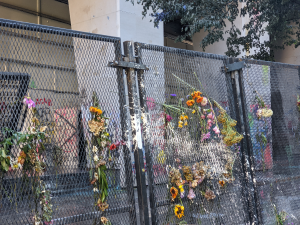
The fencing in front of the Mark Hatfield Courthouse; July 26, 2020
.
.
.
…..On the morning of Sunday, July 26, I took a short drive downtown to see the space in which the protests are taking place. While a quiet Sunday morning is hardly the same experience as the protests, I was able to get a sense of the energy.
…..What I found is pretty much what I expected, and what I have heard from reliable sources — evidence of disorder and graffiti art — mostly within a block or two in either direction of the Hatfield Courthouse. The building is surrounded by metal fencing, with flowers and miscellaneous notes and messages clinging to it. There was also a tent village in Lownsdale Square directly across the street, and to a lesser degree in Chapman Square in the next block. The Multnomah County Justice Center across the street from Lownsdale has its windows and entrance boarded up, and a relatively small amount of graffiti on the building itself. If you walk two blocks in either direction of Hatfield Courthouse, the vandalism is sparse, although there is little doubt the protest activity is impacting business in the area.
…..It seems as if much of the graffiti is “new,” likely since Trump sent the Feds in, and is mostly directed at supporting BLM, while also railing against the Feds and the local police. Few messages seem directed at Trump, the mayor, or any other specific individuals.
…..In addition to tents, Lownsdale Square has a community market of sorts, as well as a few folks offering food to those in need. The air is pungent, thick, gritty, but the scene was very calm.
…..Here are some pictures from the scene in the Park, and around the area of the protests.
.
.
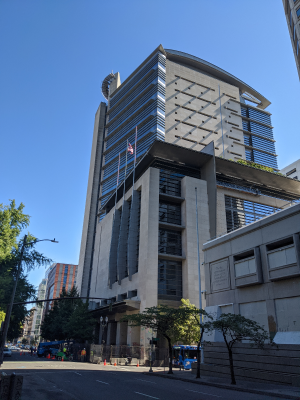
The Mark Hatfield Courthouse
.
.
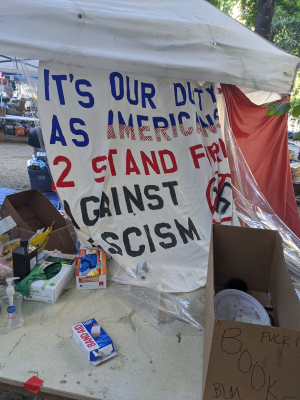
.
.
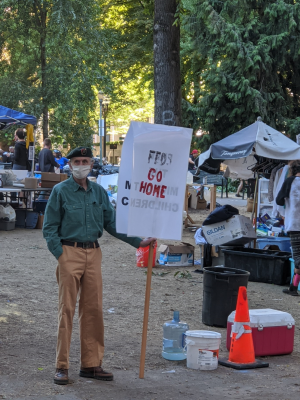
.
.
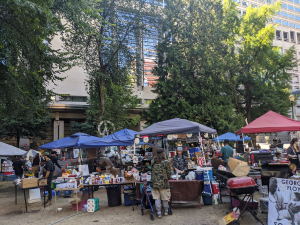
.
.
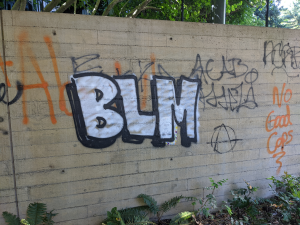
.
.
.
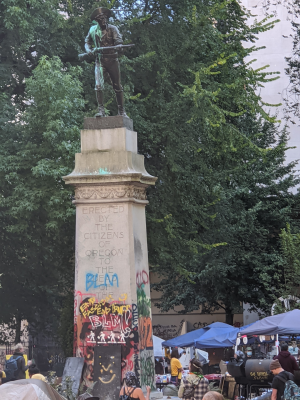
.
.
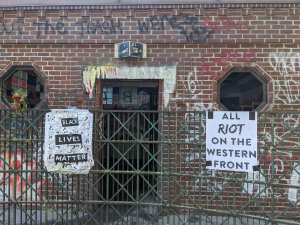
.
.
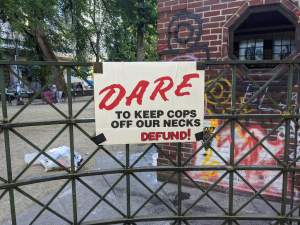
.
.
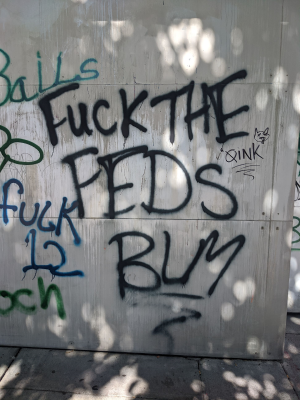
.
.
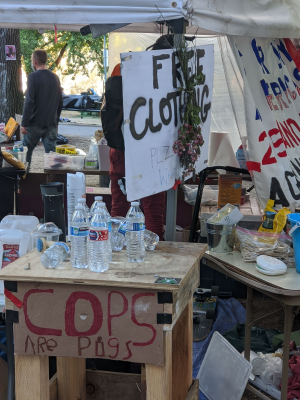
.
.
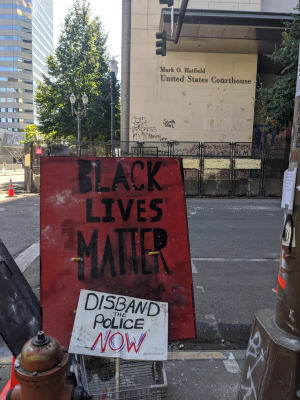
.
.
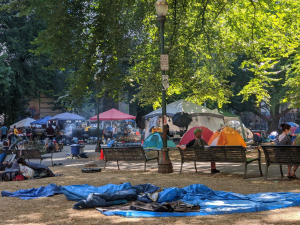
.
.
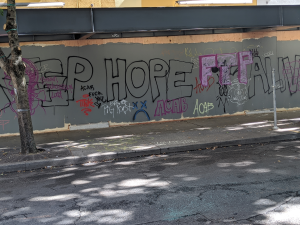
.
.
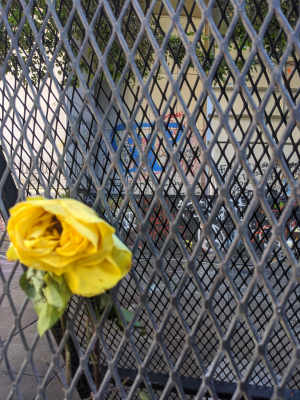
.
.
.






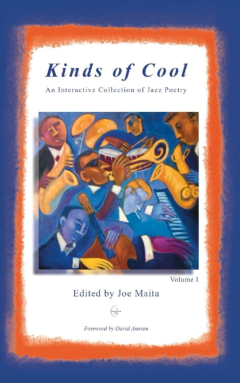

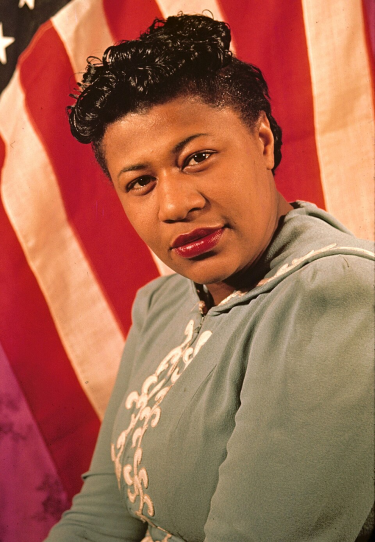







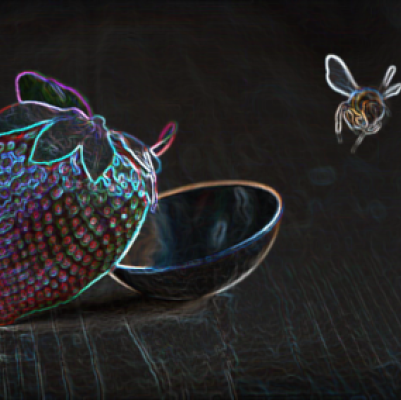






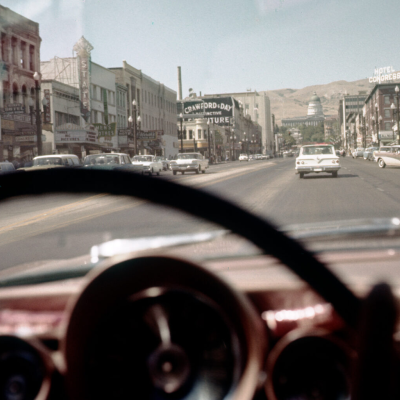















Great article and photo, sharing.
A city with a complicated history, as most of our cities seem to be. Thank you for an insider’s view!